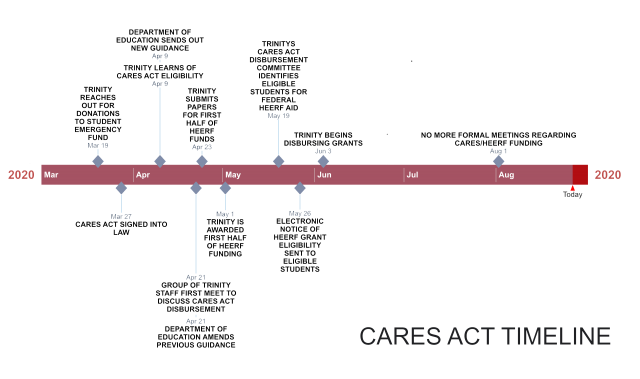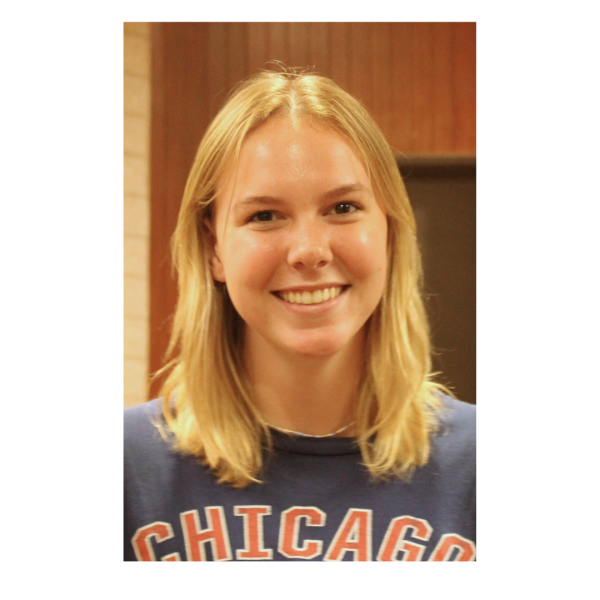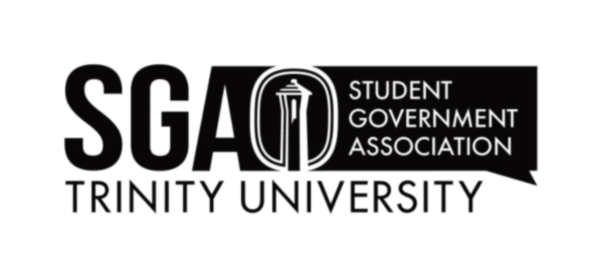CARES funding distributed to students over summer
Graphic by Nadia Crawford

“Everyone was affected by this in some way, right? But particularly, our students with the most financial need were affected the most,” said Eric Maloof, Vice President for Enrollment Management, a direct supervisor of Student Accounts, the on-campus unit in charge of collecting money from and reimbursing students.
According to Trinity University’s CARES Act Compliance site, Trinity learned that it was eligible for CARES Act funding on April 9, 2020. Of the total $2.2 trillion economic stimulus, $14 billion made up the Higher Education Emergency Relief Fund (HEERF).
The University received the first half ($832,754) of total federal funding ($1,665,508) for “immediate” disbursement to students in financial need, as stipulated by Betsy DeVos, U.S. Department of Education Secretary, in a letter informing institutions of their eligibility for aid.
An ad-hoc committee formed to discuss Trinity’s CARES Act funding. This committee included Christina Pikla, Director of Student Financial Services and Student Accounts, and Alex Serna-Wallander, Chaplain. Representatives from the Business Office, Student Financial Services, Student Life, and the Office of Strategic Communications and Marketing were also involved in weekly conversations to clarify the Department of Education’s frequently-amended stipulations.
Trinity CARES Act committee began meeting on April 21 to determine how to disburse the money fairly; the Department of Education continued to release new guidance on disbursements.
“When the Department of Education first gave their initial guidance … it was as clear as mud. There was a lot of ambiguity. As much as we wanted to get money into the hands of students as quickly as possible, we also didn’t want to distribute that money in an incorrect way, in a way that would come back to haunt the University.” said Maloof.
The original stipulations from the Department of Education regarding HEERF funding disbursement to students stated that institutions distribute no less than 50% of the total CARES funding to students with financial need and that some students aided should fall within Pell Grant eligibility. Later, DeVos also specified that the students aided must also be Title IV eligible.
“The committee wanted to determine an approach that seems fair and reasonable within the guidance provided by the Department of Education provided at that point in time, and determine how we were going to allocate these dollars,” said Pikla.
The committee also determined that they did not want to add additional pressure to students to fill out applications to receive the HEERF funding.
“We made the decision to look at all of our undergraduate and graduate students and decided to distribute the monies to those people who filed the FAFSA for the 19-20 Academic year, Title IV eligible and had demonstrated financial need,” said Maloof.
To date, a total of 1238 Trinity students received aid in total from this fund. Eight hundred sixty-six non-Pell-Grant eligible students received approximately $650 and 372 Pell Grant eligible students received approximately $820 each. These numbers include students who were studying abroad during the Spring 2020 semester.
“We knew we needed to get this into the hands of our students, as quickly as possible,” said Maloof.
In addition to disbursing the entirety of the first half of the federal funding, Trinity University fronted an additional $53,589.39, totaling the amount of COVID-19 aid given to students from Trinity University to $886,343.39. Maloof disclosed that the University will be reimbursing themselves for this additional amount once Trinity receives the second half of HEERF aid.
“We also are aware that the amounts that we provided, while they were helpful, I’m sure, and our students appreciated it, many students’ needs greatly exceeded what we were able to do there; which is why we set up the other emergency fund, overseen by Chaplain Alex and Dean Tuttle,” said Maloof.
The Student Emergency Fund had been created in honor of Reverend Raymond Judd, who was the University Chaplain from 1967-1999.
“The Judd Student Emergency Fund is entirely from charitable gifts. It was a fund we already had that the Chaplain used to help kids on a one-on-one basis or when they were in crisis. “ said Michael Bacon, Vice President for Alumni Relations & Development.
Since mid-March, over $125,000 has been provided directly to students from the Student Emergency Fund.
“What was remarkable to me was for how many students were at Trinity … it was the safest place they could be in terms of food and housing security. So we knew we would have some people with extraordinary needs,” said Bacon.
Kathy McNeill, Senior Director for Annual Giving Programs, was in charge of the concerted effort to reach out to alumni, faculty, staff and parents for monetary donations for the Judd fund.
“Alumni were calling us like crazy asking what can I do, how can I help? Does somebody need a place to stay? We really worked to translate that into: what do kids need and how can we help them? It was actually money, not just credit or something on their account, it was actually money,” said Michael Bacon.
McNeill was in charge of creating a website for donation collections and reaching out to potential donors through email and social media.
“We raised close to $130,000 from the entire Trinity community,” said McNeill. These donations were added to the Raymond Judd fund and were raised in about a month and a half before the CARES Act funding was distributed.
When distributing the CARES Act fund, the Department of Education not only was unclear but also restricted the pool of eligible students to exclude international or undocumented students who did not fill out the 2019-2020 FAFSA.
“I was a Director of International Students before this. No one wanted to take care of international students more than I did. But in the wording from the Department of Education, and their guidance, we were not permitted to provide this money to those students. But we were able to capture those students’ [financial needs] in other ways. The risk of going against their guidance meant that they could strip it away from us,” said Maloof.
Trinity’s Student Emergency Fund did not keep track of student’s citizenship or other demographics when handing out emergency grants, according to Chaplain Alex Serna-Wallander.
Other national controversy surrounded universities taking CARES Act funding despite their large endowments. Harvard and Princeton, with $20-40 billion endowment funds, eventually rejected their CARES Act funding. Trinity, with a $1.28 billion endowment, accepted the funding. When asked about why Trinity took the funding in the first place, Eric Maloof responded in the following way.
“To provide a Trinity-level education and make it affordable for all students from different socioeconomic backgrounds to attend, including the freshman class that is 20 percent Pell Grant eligible, is an extraordinarily expensive endeavor. To be a better Trinity tomorrow than we are today, it’s going to take extensive resources,” said Maloof.
Maloof emphasized that the funding was meant to help students first, along with the institution to recover from losses as a result of COVID-19.
“I don’t think that people can underestimate the amount of money lost by colleges during this pandemic. Not only have lost but are losing and will continue to lose in the future. There is no silver lining financially for students, their families, and colleges,” said Maloof.





